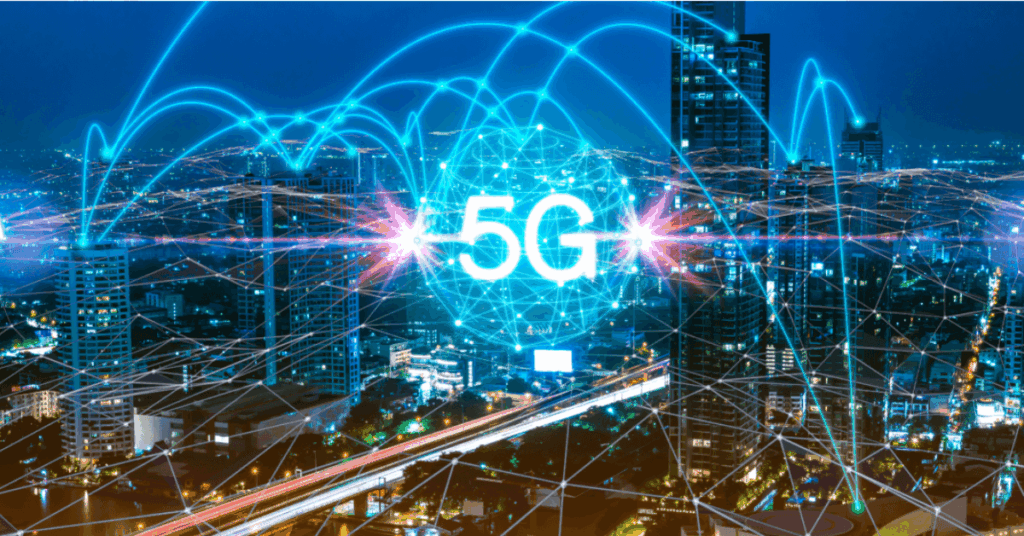Anúncios
The world spins faster now, and 5G is the invisible thread weaving through our daily digital tapestry, promising speed, connection, and possibilities we’re only beginning to imagine.
🌐 The Dawn of a New Wireless Era
Picture yourself standing at the edge of a technological revolution. The air crackles with invisible signals, each one carrying more data than you could have dreamed of just a decade ago.
Anúncios
This isn’t science fiction—this is the reality of 5G technology, and it’s reshaping how we interact with the digital world.
Fifth-generation wireless technology represents more than just an incremental upgrade.
Anúncios
It’s a fundamental reimagining of connectivity, where downloads that once took minutes now complete in seconds, where lag becomes a distant memory, and where the Internet of Things transforms from concept to everyday reality.
But here’s the beautiful paradox: while 5G networks expand across cities like digital vines climbing invisible trellises, many users remain uncertain whether their devices can even tap into this power.
The phone in your pocket might be a gateway to extraordinary speeds, or it might be waiting for you to unlock its potential.
📱 Decoding Your Device’s Hidden Capabilities
Every smartphone tells a story through its specifications, and understanding whether yours speaks the language of 5G requires a bit of detective work. The good news? You don’t need a degree in telecommunications to figure it out.
Your device’s compatibility with 5G networks depends on several factors woven together like threads in a complex tapestry. The processor, the modem chip, the antenna configuration—each plays a crucial role in determining whether you can access these next-generation speeds.
The Quick Verification Method
Start with the simplest approach: dive into your phone’s settings. On most Android devices, navigate to Settings, then tap on “Network & Internet” or “Connections.” Look for mobile network options, and you’ll typically find a section labeled “Preferred network type” or “Network mode.”
If you see options listing 5G—whether it’s labeled as “5G,” “5G/LTE,” or “5G/4G/3G/2G auto connect”—congratulations! Your device has the hardware necessary to connect to 5G networks. The presence of these options is like finding a hidden door in your favorite room, one that leads to faster, more responsive connectivity.
For iPhone users, the journey is equally straightforward. Open Settings, tap “Cellular,” then “Cellular Data Options,” and finally “Voice & Data.” If 5G options appear here, your device is ready to embrace the future.
🔍 Deep Diving into Device Specifications
Sometimes, the surface-level investigation isn’t enough. Perhaps you’re considering purchasing a new device, or maybe you want absolute certainty about your current phone’s capabilities. This is where specification sheets become your best friend.
Every smartphone manufacturer publishes detailed specifications for their devices. These documents read like technical poetry, describing the intricate components that bring your device to life. Look for mentions of 5G bands, frequency support, or explicit statements about 5G compatibility.
The plot thickens when you realize that not all 5G is created equal. There are multiple flavors: low-band 5G offers widespread coverage with modest speed improvements, mid-band delivers a balance of coverage and performance, while millimeter-wave (mmWave) provides breathtaking speeds over shorter distances.
Understanding 5G Band Support
Think of 5G bands as different channels on a vast radio spectrum. Your phone needs to support the specific bands that your carrier uses in your region. A device that works perfectly on one carrier’s 5G network might not access another carrier’s network with the same efficiency.
Common 5G bands include n1, n3, n5, n7, n8, n20, n28, n38, n40, n41, n66, n77, n78, and n79. The millimeter-wave bands—n260, n261—represent the cutting edge, though they’re less commonly deployed due to their limited range.
⚡ Activating Your 5G Connection
Discovering your phone supports 5G is only half the adventure. Activation is where theory meets practice, where potential becomes reality. The process varies slightly depending on your device and carrier, but the fundamental steps remain consistent.
First, ensure your carrier plan includes 5G access. Not all wireless plans automatically grant access to 5G networks—some require specific plan upgrades or additions. Contact your carrier or check your account online to verify your plan’s capabilities.
Once you’ve confirmed your plan supports 5G, it’s time to enable it on your device. On Android phones, return to the Settings menu, navigate to “Network & Internet,” then “Mobile Network,” and select “Preferred network type.” Choose the option that includes 5G—it might be labeled “5G/LTE/3G/2G (auto connect)” or simply “5G.”
Fine-Tuning Your 5G Experience
Modern smartphones often offer multiple 5G modes, each balancing speed against battery consumption differently. Understanding these options empowers you to customize your experience.
The “5G Auto” or “Smart 5G” mode intelligently switches between 5G and LTE based on your usage patterns and network availability. This option preserves battery life while still providing 5G speeds when you need them most.
“5G On” or “Always 5G” keeps your device constantly connected to 5G networks when available, maximizing speed at the potential cost of battery longevity. This mode is perfect for users who prioritize performance above all else.
Some devices also offer a “5G On, LTE Off” mode, which might seem appealing but can actually hinder your experience in areas with spotty 5G coverage. The sweet spot for most users lies in the automatic switching modes.
🗺️ Navigating the Coverage Landscape
Even the most capable device becomes a dreamer without network support. 5G coverage remains a work in progress, expanding daily but still far from universal. Understanding your local coverage situation sets realistic expectations.
Major carriers provide coverage maps on their websites, painting digital landscapes that show where 5G signals reach. These maps distinguish between different 5G types—low-band, mid-band, and mmWave—each represented by different colors or patterns.
Urban centers typically enjoy the most robust 5G deployment. Cities serve as testing grounds and showcases for this technology, their dense populations and concentrated infrastructure making them ideal candidates for aggressive rollouts.
Suburban and rural areas present more complex challenges. The physics of wireless transmission mean that lower-frequency 5G bands work better across distances and through obstacles, making them more suitable for these regions. The ultra-fast mmWave spectrum, conversely, requires nearly line-of-sight connections and works best in dense urban environments.
🛠️ Troubleshooting Common Connection Issues
Technology, for all its wonder, occasionally stumbles. When your 5G connection refuses to cooperate, a systematic approach to troubleshooting usually reveals the culprit.
Start with the basics: ensure your device’s software is current. Manufacturers regularly release updates that improve network connectivity, fix bugs, and expand 5G band support. These updates are like tune-ups for your device’s wireless capabilities.
If you’re in an area with confirmed 5G coverage but can’t connect, try toggling airplane mode on and off. This simple action forces your device to re-establish its network connections, often resolving temporary glitches.
SIM Card Considerations
Your SIM card acts as your digital identity on cellular networks, and older SIM cards might not fully support 5G connectivity. If your phone and plan both support 5G but you’re not connecting, your carrier might need to provision a new 5G-compatible SIM card.
Many carriers now offer eSIM technology, which eliminates physical SIM cards entirely. These digital SIMs often provide smoother 5G experiences and can be activated or switched remotely, adding convenience to capability.
💡 Maximizing Your 5G Investment
Once you’ve unlocked 5G on your device, a world of enhanced experiences awaits. But understanding how to leverage this technology transforms it from a mere speed increase into a genuine game-changer.
Streaming high-definition video becomes effortless. Where buffering once interrupted your viewing experience, 5G delivers smooth playback even at 4K resolutions. The technology’s low latency means controls respond instantly, making cloud gaming feel remarkably similar to local play.
Video calls gain new clarity and stability. The combination of faster upload speeds and reduced latency creates more natural conversations, where facial expressions and gestures translate without awkward delays. Remote work and distance learning benefit enormously from these improvements.
The Creative Possibilities
Content creators find 5G particularly transformative. Uploading high-resolution photos and videos to social platforms or cloud storage services that once required WiFi connections can now happen anywhere with 5G coverage. This mobility unlocks creative workflows previously confined to studios or homes.
Augmented reality applications flourish on 5G networks. The low latency enables real-time rendering of virtual objects overlaid on the physical world, creating seamless experiences where digital and physical realities blend.
🔋 Balancing Speed with Battery Life
Every technological advancement carries trade-offs, and 5G’s relationship with battery life represents one of the most significant. Understanding this dynamic helps you make informed decisions about when to prioritize speed versus longevity.
5G modems consume more power than their 4G predecessors, particularly when maintaining connections to faster but more power-hungry frequency bands. This increased consumption can noticeably impact your device’s battery life, especially during heavy use.
Smart management strategies help mitigate these effects. Using your phone’s automatic 5G modes allows the device to intelligently switch between 5G and LTE based on your needs. When you’re browsing text-heavy websites or using apps that don’t require high bandwidth, your phone conserves battery by connecting to LTE.
During periods when you need maximum battery longevity—long trips without charging access, for instance—temporarily switching to LTE-only mode can significantly extend your device’s runtime. The speed difference for basic tasks remains minimal, while the battery savings accumulate meaningfully.
🌟 Looking Toward Tomorrow’s Connections
The 5G networks operating today represent just the beginning. As infrastructure matures and devices evolve, the technology’s full potential will gradually reveal itself like a photograph developing in solution.
Standalone 5G networks—those that operate independently of 4G infrastructure—promise even greater improvements. Current non-standalone implementations rely partially on existing 4G networks, limiting some of 5G’s theoretical capabilities. As carriers complete their standalone deployments, users will experience the technology’s true power.
The Internet of Things will bloom on 5G’s fertile ground. Smart cities, connected vehicles, remote healthcare, and industrial automation all depend on the reliable, low-latency connections that 5G provides. Your phone becomes not just a communication device but a control center for an increasingly connected world.
🎯 Making the Compatibility Decision
If you’re contemplating a new device purchase, 5G compatibility should weigh heavily in your decision. While 4G networks will continue operating for years, investing in 5G-capable hardware future-proofs your purchase and ensures you’ll benefit as coverage expands.
Consider your typical usage patterns and geographic location. Urban dwellers who frequently stream video, participate in video calls, or work remotely will likely appreciate 5G’s benefits immediately. Those in rural areas or who primarily use their phones for basic communication might find the current advantages less compelling.
Price premiums for 5G-capable devices continue shrinking as the technology matures. Mid-range phones now routinely include 5G support, democratizing access to this technology beyond flagship devices.
🔐 Security in the 5G Landscape
As with any connectivity evolution, security considerations accompany 5G’s arrival. The technology includes enhanced security features at the protocol level, but user vigilance remains essential.
5G networks implement stronger encryption standards and improved authentication mechanisms compared to previous generations. These enhancements make intercepting or spoofing connections more difficult, protecting your data as it travels through the air.
However, the endpoints—your device and the services you connect to—remain potential vulnerability points. Maintaining updated software, using VPNs on public networks, and practicing good digital hygiene remain as important as ever, regardless of your connection speed.

✨ Embracing the Connected Future
Checking and activating 5G compatibility on your phone represents more than a technical exercise. It’s an invitation to participate in a fundamental shift in how we connect, communicate, and create in our increasingly digital world.
The steps are straightforward: verify your device’s capabilities through settings or specifications, confirm your carrier plan includes 5G access, activate the appropriate network modes, and optimize your usage patterns to balance speed with battery life. These simple actions unlock doors to experiences that seemed impossible just years ago.
As 5G networks continue expanding and evolving, early adoption positions you at the forefront of this transformation. You’ll watch as the technology matures, as new applications emerge, and as our collective digital experience accelerates toward futures we’re still imagining.
The power of 5G doesn’t lie solely in its speed—though that speed is remarkable. Its true potential rests in the possibilities it enables, the barriers it removes, and the connections it strengthens. Your phone, equipped and activated for 5G, becomes a portal to this emerging reality, ready to carry you forward into tomorrow’s wireless world.





